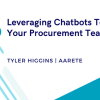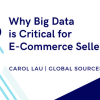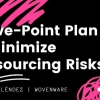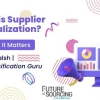Historically, for organizations looking to improve their top or bottom line and gain competitive advantage, leveraging technology has always been considered. As we enter the next industrial revolution, Artificial Intelligence (AI) in our future is no exception. The interest and benefits of AI increase significantly across all industries and functions. The rewards continue to be meaningful for any organization looking to gain productivity and competitive advantage using AI.
Getting Started
To reap the benefits of AI, piloting a Proof of Concept (known as a PoC) is a logical first step to build your own AI models or solutions.
PoCs are working solutions that can be evaluated and tested with a definite success criterion, from understanding requirements to delivering success. PoCs are useful to measure the rewards and challenges that can help better prepare the organization. AI help decision-makers gain immediate benefits such as skills and experience, the ability to identify and resolve potential data bottlenecks, an understanding of AI’s positive impacts and increased stakeholder trust.
Identify the Opportunity
In planning or piloting an AI PoC, you first need to identify an opportunity. From the beginning, you must be clear with what you want to achieve with AI, why it matters for your organization and how confident you are that it can deliver. You should also assess how AI can make a difference in your business. You may need to be prepared to reimagine your existing processes and ensure that resources are skilled-up to reap the most benefits possible.
Market Pulse
Next, you will want to understand what others in your industry are doing with AI, in what areas they are considering it, and what successes or challenges they have faced. I recommend speaking to your supplier partners to better understand their roadmap and how it may fit your needs.
Supplier partners are excellent sources for insights into where AI can benefit the business. Suppliers can even help you prepare a business case and understand market dynamics. This homework will help identify areas within your organization where AI can add value and help solve business problems.
Build vs. Buy
Now you want to consider whether to build a solution or buy It. Depending on the use case you identified above, it will be easy to decipher which direction to take. Here are three key reasons why it makes sense to consider building an AI solution:
- You want to create your intellectual property through algorithm creation.
- You are investing in data science, AI and engineering teams, specifically to productize the outcome of your project.
- You need to create a proprietary platform with dedicated teams that can perform maintenance, management and upkeep.
If these are not your intended outcomes or plan of investment, your best course of action is to buy a pre-built solution. You can easily leverage a packaged solution in which the supplier has already made these investments to address similar use cases. In this "buy" scenario, a PoC would be overkill. What becomes more important is your willingness to change your existing processes to accommodate the AI-driven solution.
For buying a packaged solution, you can simply try it and see if it solves your use case. When you purchase a pre-built solution, you leverage market-relevant data to improve your capabilities. So, your efforts should center on whether the solution fits your use case and enhances your current method of operations.
Regardless, you will need to determine if it will work with your existing team and the experience available in-house, or whether you need to bring in experts who can bridge the skills gap.
>> Intelligent Automation: Must-have skill for tomorrow's procurement professionals. <<
Prepare Your Pitch
Let's assume you have identified areas in which AI can benefit your company, function, business problems or processes. Now you can pressure test this to reveal gaps in your planning or understanding as part of your pitch. Anyone you will bring onboard will want to know answers to these questions:
- What is the problem we are looking to solve?
- What are the specific requirements, what will we need and how difficult will it be for us?
- How will we measure success?
- Have we considered other methods to deal with this problem before choosing AI?
- Is there sufficient executive buy-in?
- Have we lined up the right resources to make this happen?
- Are the data sources we need accessible without technological and other impediments?
- Is the impact it will make in our business significant enough to deserve the effort?
- Is the team on the ground set up with the right timeframe, skills and motivation?
- Following a successful PoC, will there be funding available to continue or scale up the solution?
- Have we included our operational IT department and are you both collaborating actively?
- Have we identified the "domain experts" to ensure they have the bandwidth available to focus on the project?
- Have we committed to making process changes necessary to reap most benefits from AI?
Anticipate the Unexpected
You must remember that AI technology has its challenges, too. Success and failure are not far apart, so it’s important to remind stakeholders that there will be obstacles and unexpected challenges.
Prepare yourself with a game plan:
- AI cannot replace every task.
- Investments will be necessary to reimagine processes and upskill talent.
- Software malfunctions can occur, so itmust be planned for.
- Keep expectations realistic about what AI can and cannot do.
There is a belief that AI is magic and can do any job, no matter how small or large. It’s important to remind everyone on the AI journey that it will increase productivity by taking over a tedious task from humans, resulting in performance and efficiency gains.
Plan for the Unexpected
Since the investment required for AI is high, not all businesses have the resources to know where to look or how it can be most beneficial. Assuming that you have a well laid-out business case, remind everyone that large portions of the investments are in reimagining the processes, data accessibility, creating and training the models, testing the algorithms and accessing talent.
When building an AI-driven solution, since there are built-in algorithms, it is harder to blame a human when things go wrong. To ensure this doesn't affect your business, have well-defined back-up and business continuity plans.
Also, it’s important to manage expectations about AI because not everyone understands how it works. Some will see it as a tool for adding to their existing processes to claim transformation. Others will do it because it’s the latest trend, so they will think about things that are not even possible with AI. While the experts are confident that AI will rule the next era, the fact is that it is still in its initial phase.
AI and Data Governance
AI learns what it is taught, so if you don’t invest in appropriate training to match expectations, there will be a disappointment in its benefits.
An often-missed aspect of AI is the governance process, regardless of whether it's for your own AI solution or a purchased solution. If done right, this process should help identify and remove biases so that an AI-driven process doesn't amplify biases and can act as checks and balances.
Governance can improve collaboration to simplify the end-to-end process, provide quicker decision-making and enhance the end-user experience. The difference for those who reap substantial benefits is they plan a process with AI in mind instead of adding AI as a tool in their existing operations or process.
As a result, the leaders driving the change will need to have a practical mindset, the vision to improve the status quo, embrace a teamwork-based success approach, and be committed to resource availability, updating processes and investments necessary.
Gain Organizational Support
To successfully implement AI, organizational support is critical. When you consider that most people can't even tell when they are dealing with AI, this task automatically becomes harder. For this reason, it's good to start small. Larger AI projects take longer to show results, so be clear about the goals, benefits and how you plan to measure success.
Once you define your project in terms of goals rather than the technology you'll use, it will be easier to bring people on board. When presenting your AI project, keep your organization's culture and the tech know-how of your colleagues in mind.
Work closely within the organization to ensure that your colleagues retain their current status and responsibilities. If need be, educate to help overcome the fear of technology to ease individual concerns. Fear of job loss and change are the key reasons people have difficulty embracing AI and often this includes the highest of functional executives.
Secure Buy-In
If the CEO is all-in but the lieutenants are fearful of AI, they will resist for as long as possible. If the CEO and their lieutenants are all-in, the next step is to put the "domain experts" or "practitioners" in the driving seat.
The domain experts will be your most valuable team players. They are instrumental in successfully executing an AI project because they can translate how AI fits in the business process flow and spot what may need to change.
Domain experts can better identify the pitfalls, train AI and be a direct beneficiary of productivity gains. They will be excited about using AI to reduce transactional processes with mundane administrative tasks that have over-burgeoned them and their teams.
I recommend including everyone to develop a cadence for communications. An AI project done in isolation with a small team will struggle to get buy-in moreseo than a project with shared ownership from a larger group of constituents. So, make it accessible to as many people as possible. The collaboration will help with buy-in for present and future projects. Partnering with open-minded individuals who can see the possibilities will help navigate you through difficulties as they arise.
I hope this will help anyone considering AI to reimagine and pivot. Enjoy your exciting journey to benefitting from AI!









